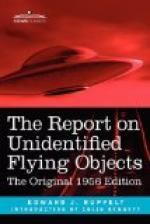The powers-that-be at ATIC O.K.’d the plan in December and it went to Washington, where it would have to be approved by General Samford before it went to ADC and then back to the Pentagon for higher Air Force official blessing. From all indications it looked as if we would get the necessary blessings.
But the majority of the effort at Project Blue Book during the fall of 1952 had gone toward collecting together all of the bits and pieces of data that we had accumulated over the past year and a half. We had sorted out the best of the “Unknowns” and made studies of certain aspects of the UFO problem, so that when we could assemble a panel of scientists to review the data we could give them the over-all picture, not just a basketful of parts.
Everyone who knew about the proposed panel meeting was eager to get started because everyone was interested in knowing what this panel would have to say. Although the group of scientists wouldn’t be empowered to make the final decision, their recommendations were to go to the President if they decided that the UFO’s were real. And any recommendations made by the group of names we planned to assemble would carry a lot of weight.
In the Pentagon and at ATIC book was being made on what their recommendations would be. When I put my money down, the odds were 5 to 3 in favor of the UFO.
CHAPTER FIFTEEN
The Radiation Story
The idea for gathering together a group of scientists, to whom we referred as our “panel of experts,” had been conceived early in 1952— as soon as serious talk about the possibility that the UFO’s might be interplanetary spaceships had taken hold in both military and scientific circles. In fact, when Project Grudge was reorganized in the summer of 1951 the idea had been mentioned, and this was the main reason that our charter had said we were to be only a fact-finding group. The people on previous UFO projects had gone off on tangents of speculation about the identity of the UFO’s; they first declared that they were spacecraft, then later, in a complete about-face, they took the whole UFO problem as one big belly laugh. Both approaches had gotten the Air Force into trouble. Why they did this I don’t know, because from the start we realized that no one at ATIC, in the Air Force, or in the whole military establishment was qualified to give a final yes or no answer to the UFO problem. Giving a final answer would require a serious decision—probably one of the most serious since the beginning of man.
During 1952 many highly qualified engineers and scientists had visited Project Blue Book and had spent a day or two going over our reports. Some were very much impressed with the reports—some had all the answers.
But all of the scientists who read our reports readily admitted that even though they may have thought that the reports did or did not indicate visitors from outer space, they would want to give the subject a good deal more study before they ever committed themselves in writing. Consequently the people’s opinions, although they were valuable, didn’t give us enough to base a decision upon. We still needed a group to study our material thoroughly and give us written conclusions and recommendations which could be sent to the President if necessary.




